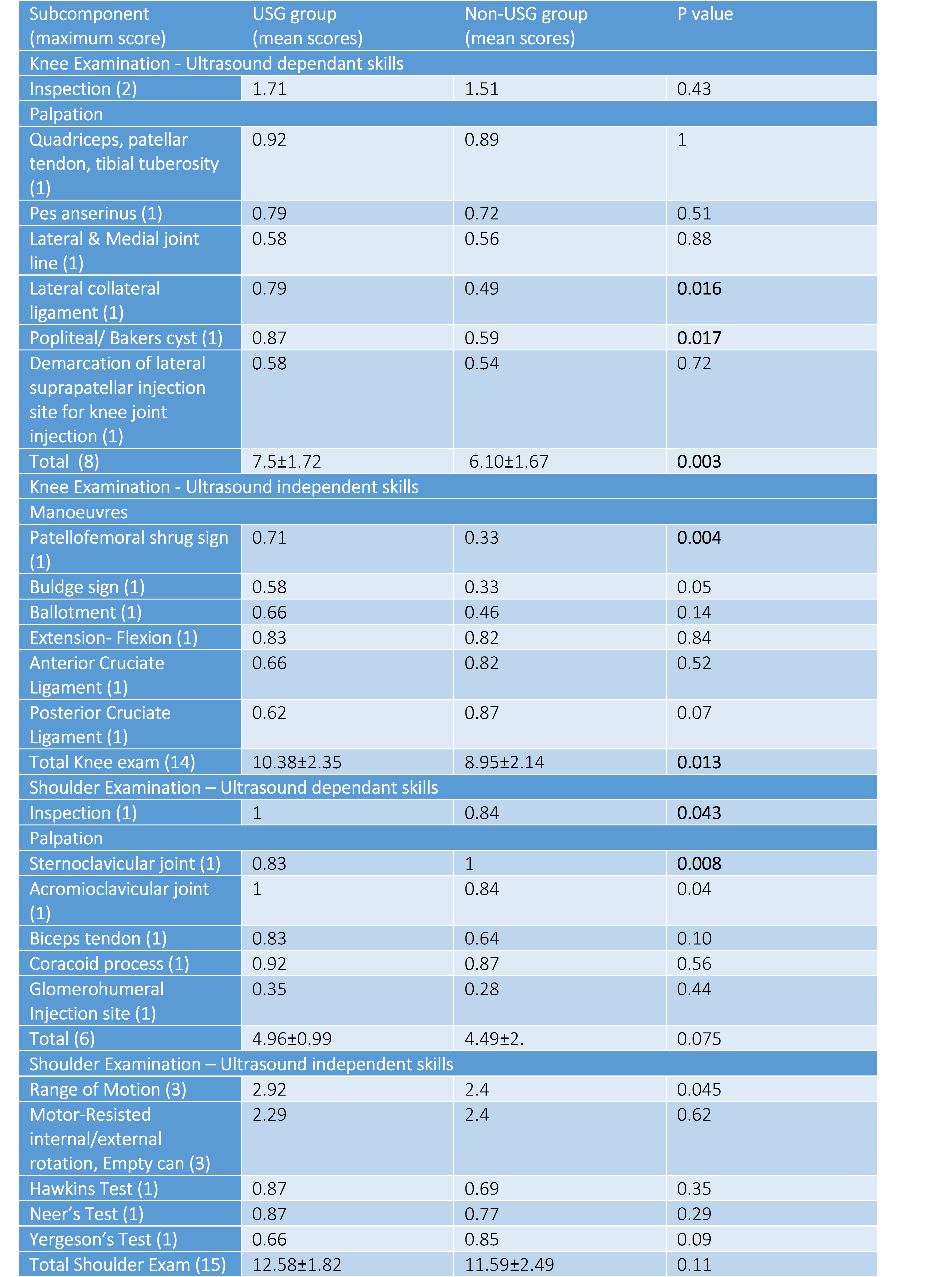Session Information
Date: Sunday, November 5, 2017
Title: Education Poster
Session Type: ACR Poster Session A
Session Time: 9:00AM-11:00AM
Musculoskeletal ultrasound provides instant feedback for spatial understanding and the evaluation of abnormalities with great precision and accuracy, and may aid in developing physical examination skills.
Methods:
We framed a teaching exercise to develop examination skills in medical students using ultrasound imaging as an aid in order to assess ultrasound utility in improving these skills. Of 158 second year medical students, 63 volunteered to participate in a 2-day musculoskeletal exercise. Students who were not able to commit to both days were excluded. On day one, all students were taught examination of the knee and shoulder in 1 hour. We randomized 24 students for inclusion of ultrasound demonstration of key joint landmarks (Ultrasound aided group-USG) within the same 1hr period.
Student performance was evaluated in a 20-minute OSCE on day 2 with standardized patients. Students were graded by an observer blinded to instruction group using a standardized checklist, that included key inspection, palpation, and maneuvers for joint exams. The study was exempted from review by the local IRB. Participant confidentiality was maintained with anonymized codes. The Mann-Whitney-Wilcoxon test was used to analyze the results given the small sample and non-normal distribution of the scores.
Results:
The maximum score for knee and shoulder examinations were 14 and 15 respectively. For the knee examination, the mean score of the USG (10.38±2.35) was significantly higher than the non-USG group (8.95±2.14) p=0.013. There was a non-significant trend towards improved performance of shoulder examination in the USG (12.58±1.82) compared to non-USG (11.59±2.49) group (p=0.11).
Since ultrasound visualization is more likely to improved inspection and palpation components, we analyzed them separately. For knee examination, the USG group fared significantly better (7.5±1.72 vs. 6.10±1.67, p=0.003); a similar trend towards improved performance in the shoulder examination, did not reach significance in the USG group (4.96±0.99 vs. 4.49±1.12, p=0.075).
In sub-components of the knee exam, significant improvement was seen in the USG-aided group in palpation of the lateral collateral ligament (p=0.016), popliteal space for Baker’s cysts (p=0.017), and the patellofemoral shrug test (p=0.004). For sub-components of the shoulder exam, improvement was significant in the USG-aided group for shoulder inspection (p=0.043), palpation of the sternoclavicular joint (p=0.008), acromioclavicular joint (p=0.043), and shoulder range of motion (p=0.045).
Conclusion:
Incorporation of ultrasound into musculoskeletal exam curriculum demonstrated short-term improvement in knee examination performance, with a trend toward improvement in shoulder exam in second-year medical students.
Table: Knee and Shoulder Exam- ultrasound vs. non-ultrasound group scores
To cite this abstract in AMA style:
Seth B, Stanfield L, Kissin EY. Focused Musculoskeletal Ultrasound Teaching: Effect on Medical Students’ Physical Examination Skills [abstract]. Arthritis Rheumatol. 2017; 69 (suppl 10). https://acrabstracts.org/abstract/focused-musculoskeletal-ultrasound-teaching-effect-on-medical-students-physical-examination-skills/. Accessed .« Back to 2017 ACR/ARHP Annual Meeting
ACR Meeting Abstracts - https://acrabstracts.org/abstract/focused-musculoskeletal-ultrasound-teaching-effect-on-medical-students-physical-examination-skills/

